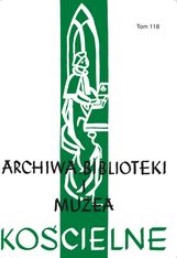KLISZE PAMIĘCI. LABIRYNTY MARIANA KOŁODZIEJA W CENTRUM ŚW. MAKSY MILIANA W HARMĘŻACH I ANONIMOWE SZKICE PRZECHOWYWANE W ZASOBACH MUZEUM GROSS -ROSEN JAKO DOKUMENTY CZASU ZAGŁADY
‘MEMORY FILES. LABYRINTHS’ AT THE ST MAXIMILIAN CENTRE IN HARMĘŻE AND ANONYMOUS SK ETCHES STORED IN THE RESOURCES OF THE GROSS-ROSEN MUSEUM AS DOCUMENTS OF THE HOLOCAUST
Author(s): Lucyna Sadzikowska, Aleksandra Giełdoń-PaszekContributor(s): Marek Robak-Sobolewski (Translator)
Subject(s): Museology & Heritage Studies, Preservation, WW II and following years (1940 - 1949), History of the Holocaust, Source Material, Politics of History/Memory, Peace and Conflict Studies
Published by: Katolicki Uniwersytet Lubelski Jana Pawła II - Wydział Teologii
Keywords: Memory Files. Labyrinths’; Marian Kołodziej; St Maximilian Centre in Harmęże; anonymous sketches; Gross-Rosen Museum in Rogoźnica; artistic activity of camp prisoners;
Summary/Abstract: On the lower floor of the Church of Our Lady of the Immaculate in Harmęże, which is part of the St Maximilian Centre, an exhibition has been installed entitled ‘Memory Files. Labyrinths’. The exhibition features drawings by Marian Kołodziej, a former Auschwitz prisoner designated as no. 432. The Archives of the Gross-Rosen Museum in Rogoźnica contain a collection of sketches by an anonymous author, most likely a prisoner at the concentration camp, as yet unpublished in their original form with back matter. The authors of this article jointly present the individual drawings by Kołodziej as well as the anonymous drawings which are preserved in the museum’s archives. Their value as testimonials is emphasised and the undeniable artistic value of the illustrations is highlighted. Both ‘Memory Files. Labyrinths’ and the drawings from Gross-Rosen, which Henryk Motowilczuk donated in 2007 to the Archives of the Gross-Rosen Museum (ref. 11022/DP), have documentary value and enrich the study on World War II. Seven compositions – drawn in pairs of two or four sheets of wrapping paper and a single drawing on three sheets – and the exhibition of Kołodziej’s drawings served as the sources for the article, which follows the case study method. From the perspective of an art historian and literary scholar, the text is a synthetic presentation of testimony: a composition of drawings created after almost 50 years of silence on the subject of Kołodziej’s experiences in the concentration camp and a document of camp life found behind a picture frame almost 60 years after the camp was liberated, seen from an individual perspective. The paper addresses the issue of the analogy of drawing to reality, touches on the essence of each sketch individually and outlines the strategies undertaken by the draughtsman.
Journal: Archiwa, Biblioteki i Muzea Kościelne
- Issue Year: 2022
- Issue No: 118
- Page Range: 335-352
- Page Count: 18
- Language: Polish

